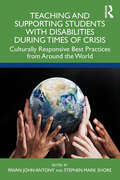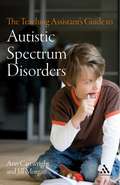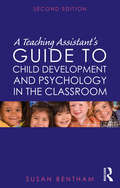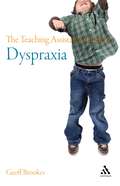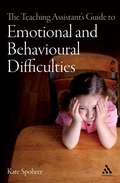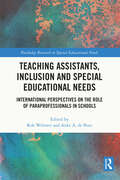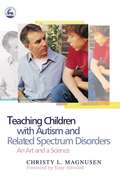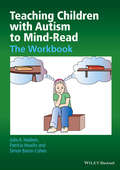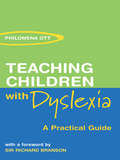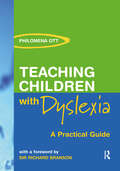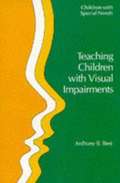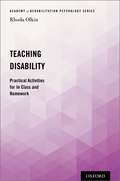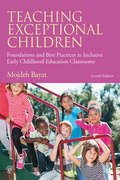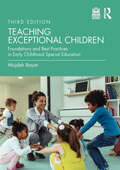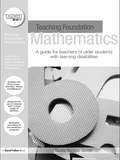- Table View
- List View
Teaching and Supporting Students with Disabilities During Times of Crisis: Culturally Responsive Best Practices from Around the World
This volume offers international perspectives on the disproportionate impact COVID-19 has had on disabled students and their families, serving as a call to action for educational systems and education policy to become proactive, rather than reactive, for future disasters. Each chapter in the book is written by authors with lived experiences across diverse global regions, highlighting the daily life of people with disabilities and their families during the pandemic. Including case studies and practical suggestions, the book demonstrates that culturally responsive practices are essential to successfully support people around the world in their times of need. At the critical intersection of education and disability human rights, this book is important for pre-service teachers, researchers, professors, and graduate students to ensure all students are supported during times of crisis.
The Teaching Assistant's Guide to Autistic Spectrum Disorders (Teaching Assistant's Series)
by Ann Cartwright Jill MorganA practical guide that will enable Teaching Assistants to understand the difficulties experienced by children on the Autistic Spectrum.
A Teaching Assistant's Guide to Child Development and Psychology in the Classroom: Second edition
by Susan BenthamHow can you help students most effectively in the classroom? As a Teaching Assistant, you play a vital role in today’s schools. This fully updated new edition will help you get to grips with the main issues to do with psychology and its role in the processes of teaching and learning. This accessible text, building on the success of a best-selling previous edition, provides informative, yet down-to-earth commentary with clear examples of how you can apply this knowledge in everyday practice. The book addresses issues including: how to support learning how to identify and cater for different learning styles teaching children with additional needs how to manage behaviour to support learning how to help children with their self-esteem and independence. This new edition includes references to up-to-date research in child development and psychology to include information regarding personalised learning, creativity, motivation, friendships skills, moral development and neuroscience. Chapters are complemented with lively case studies, self-assessment questions and examples of how to apply theory to everyday classroom practice. The reader is encouraged to develop reflective practice to best support childrens’ behaviour and learning. This reader-friendly book is an invaluable companion for every Teaching assistant, HLTA, Cover Supervisor, and anyone working in a supporting role in an educational setting.
A Teaching Assistant's Guide to Child Development and Psychology in the Classroom: Second edition
by Susan BenthamHow can you help students most effectively in the classroom? As a Teaching Assistant, you play a vital role in today’s schools. This fully updated new edition will help you get to grips with the main issues to do with psychology and its role in the processes of teaching and learning. This accessible text, building on the success of a best-selling previous edition, provides informative, yet down-to-earth commentary with clear examples of how you can apply this knowledge in everyday practice. The book addresses issues including: how to support learning how to identify and cater for different learning styles teaching children with additional needs how to manage behaviour to support learning how to help children with their self-esteem and independence. This new edition includes references to up-to-date research in child development and psychology to include information regarding personalised learning, creativity, motivation, friendships skills, moral development and neuroscience. Chapters are complemented with lively case studies, self-assessment questions and examples of how to apply theory to everyday classroom practice. The reader is encouraged to develop reflective practice to best support childrens’ behaviour and learning. This reader-friendly book is an invaluable companion for every Teaching assistant, HLTA, Cover Supervisor, and anyone working in a supporting role in an educational setting.
The Teaching Assistant's Guide to Dyspraxia (Teaching Assistant's Series)
by Geoff BrookesThis practical guide encourages teaching assistants to reflect on their practice and to put into effect strategies which will increase and improve support for dyspraxic children. Written by an experienced educator, each chapter provides teaching assistants with a range of activities to learn from.
The Teaching Assistant's Guide to Dyspraxia (Teaching Assistant's Series)
by Geoff BrookesThis practical guide encourages teaching assistants to reflect on their practice and to put into effect strategies which will increase and improve support for dyspraxic children. Written by an experienced educator, each chapter provides teaching assistants with a range of activities to learn from.
The Teaching Assistant's Guide to Emotional and Behavioural Difficulties (Teaching Assistant's Series)
by Kate SpohrerThis practical guide gives essential advice on: understanding emotional and behavioural problems; building good communication skills; managing behaviour in the classroom and developing an effective learning environment. Throughout each chapter there are exercises or questions to facilitate embedding knowledge and skills. At the end of each chapter there are multiple choice quizzes for you to reflect on what you have learned.
The Teaching Assistant's Guide to Emotional and Behavioural Difficulties (Teaching Assistant's Series)
by Kate SpohrerThis practical guide gives essential advice on: understanding emotional and behavioural problems; building good communication skills; managing behaviour in the classroom and developing an effective learning environment. Throughout each chapter there are exercises or questions to facilitate embedding knowledge and skills. At the end of each chapter there are multiple choice quizzes for you to reflect on what you have learnt.
Teaching Assistants, Inclusion and Special Educational Needs: International Perspectives on the Role of Paraprofessionals in Schools (Routledge Research in Special Educational Needs)
by Rob Webster Anke A. de BoerThis book offers the first collection of international academic writing on the topic of Teaching Assistants. It serves as an indicative summary of current research and thinking in this field and as a point of departure for future research and development. With contributions from leading researchers, the book draws together empirical work on the deployment and impact of Teaching Assistants from various perspectives and from a range of methodological approaches. It highlights and celebrates the vital everyday contributions Teaching Assistants make to their schools and their communities: from their role within classrooms, to their moment-by-moment interactions with pupils and teachers. The book examines the effect that Teaching Assistants can have on pupils’ learning and wellbeing, and considers issues of overdependence on classroom paraprofessionals and the unintended consequences to which this can lead. Bringing together work from a journal special issue with brand new and updated chapters, the contributions offer insight into the liminal space between educator, care-giver, behaviour manager, and facilitator of learning and of peer relations, which characterises the Teaching Assistant role. This timely and important book will be essential reading for academics, researchers and students interested in special educational needs, disability, and inclusion, and those interested in the wider topic of paraprofessionals in labour markets.
Teaching Assistants, Inclusion and Special Educational Needs: International Perspectives on the Role of Paraprofessionals in Schools (Routledge Research in Special Educational Needs)
by Rob Webster Anke A. De BoerThis book offers the first collection of international academic writing on the topic of Teaching Assistants. It serves as an indicative summary of current research and thinking in this field and as a point of departure for future research and development. With contributions from leading researchers, the book draws together empirical work on the deployment and impact of Teaching Assistants from various perspectives and from a range of methodological approaches. It highlights and celebrates the vital everyday contributions Teaching Assistants make to their schools and their communities: from their role within classrooms, to their moment-by-moment interactions with pupils and teachers. The book examines the effect that Teaching Assistants can have on pupils’ learning and wellbeing, and considers issues of overdependence on classroom paraprofessionals and the unintended consequences to which this can lead. Bringing together work from a journal special issue with brand new and updated chapters, the contributions offer insight into the liminal space between educator, care-giver, behaviour manager, and facilitator of learning and of peer relations, which characterises the Teaching Assistant role. This timely and important book will be essential reading for academics, researchers and students interested in special educational needs, disability, and inclusion, and those interested in the wider topic of paraprofessionals in labour markets.
Teaching Children with Autism and Related Spectrum Disorders: An Art and a Science (PDF)
by Anthony Attwood Christy MagnusenBased on twenty-five years of teaching and working with children who have Autism Spectrum Disorders (ASDs), Christy L. Magnusen contends that it is those teachers who can blend the 'science' of education methodology with the 'art' of teaching who are best able to reach these children. Examining both these aspects of teaching, she takes a fresh look at established and more recent teaching methods such as structuring spaces, emphasizing language and planning strategies for transition and generalization, and then explores the art of implementation: why, when and how these techniques should be applied. By highlighting workable solutions to everyday problems, and emphasizing that teachers need to understand techniques and have the ability to adapt them to the situation that faces them, this book will be invaluable to all those involved in teaching children with ASDs.
Teaching Children with Autism and Related Spectrum Disorders: An Art and a Science
by Christy Magnusen Anthony AttwoodBased on twenty-five years of teaching and working with children who have Autism Spectrum Disorders (ASDs), Christy L. Magnusen contends that it is those teachers who can blend the 'science' of education methodology with the 'art' of teaching who are best able to reach these children. Examining both these aspects of teaching, she takes a fresh look at established and more recent teaching methods such as structuring spaces, emphasizing language and planning strategies for transition and generalization, and then explores the art of implementation: why, when and how these techniques should be applied. By highlighting workable solutions to everyday problems, and emphasizing that teachers need to understand techniques and have the ability to adapt them to the situation that faces them, this book will be invaluable to all those involved in teaching children with ASDs.
Teaching Children with Autism to Mind-Read: The Workbook
by Julie A. Hadwin Patricia Howlin Simon Baron-CohenThis workbook expands upon the authors? Teaching Children with Autism to Mind-Read: A Practical Guide to present the most effective approaches, strategies, and practical guidelines to help alleviate social and communication problems in individuals with Autism Spectrum Disorders (ASD). Complements the best-selling Teaching Children with Autism to Mind-Read: A Practical Guide for use in practical settings Answers the need for more training of professionals in early interventions for children assessed with ASD called for by the National Plan for Autism Written by a team of experts in the field Covers issues such as how to interpret facial expressions; how to recognize feelings of anger, sadness, fear and happiness; how to perceive how feelings are affected by what happens and what is expected to happen; how to see things from another person?s perspective; and how to understand another person?s knowledge and beliefs
Teaching Children with Autism to Mind-Read: The Workbook
by Julie A. Hadwin Patricia Howlin Simon Baron-CohenThis workbook expands upon the authors? Teaching Children with Autism to Mind-Read: A Practical Guide to present the most effective approaches, strategies, and practical guidelines to help alleviate social and communication problems in individuals with Autism Spectrum Disorders (ASD). Complements the best-selling Teaching Children with Autism to Mind-Read: A Practical Guide for use in practical settings Answers the need for more training of professionals in early interventions for children assessed with ASD called for by the National Plan for Autism Written by a team of experts in the field Covers issues such as how to interpret facial expressions; how to recognize feelings of anger, sadness, fear and happiness; how to perceive how feelings are affected by what happens and what is expected to happen; how to see things from another person?s perspective; and how to understand another person?s knowledge and beliefs
Teaching Children with Dyslexia: A Practical Guide
by Philomena OttTeaching Children with Dyslexia is essential reading for any teacher, Special Educational Needs Co-ordinator or teaching assistant who wants an insider's account of what dealing successfully with dyslexia entails.Written by one of the most well-regarded practitioners in the field with over twenty-five years' experience, this book is packed full with photocopiable exercises, activities and recommendations for resources, tests, teaching methods, advice and suggestions for strategies and techniques that are instantly transferable to classroom environments. This essential teaching companion includes chapters on: how to spot dyslexia screening and assessment tests why it does not have to be hell to learn to spell strategies for success for reluctant writers meeting the challenge of dyslexia in adolescence. Written specifically to bolster teachers' confidence and empower them with the key to unlocking literacy problems in their most challenging pupils, this resource book should be on the shelf of every staff room.
Teaching Children with Dyslexia: A Practical Guide
by Philomena OttTeaching Children with Dyslexia is essential reading for any teacher, Special Educational Needs Co-ordinator or teaching assistant who wants an insider's account of what dealing successfully with dyslexia entails.Written by one of the most well-regarded practitioners in the field with over twenty-five years' experience, this book is packed full with photocopiable exercises, activities and recommendations for resources, tests, teaching methods, advice and suggestions for strategies and techniques that are instantly transferable to classroom environments. This essential teaching companion includes chapters on: how to spot dyslexia screening and assessment tests why it does not have to be hell to learn to spell strategies for success for reluctant writers meeting the challenge of dyslexia in adolescence. Written specifically to bolster teachers' confidence and empower them with the key to unlocking literacy problems in their most challenging pupils, this resource book should be on the shelf of every staff room.
Teaching Children With Visual Impairments (PDF)
by Tony BestA guide for teachers and parents. Discusses the range and definitions of visual impairment, its population and history, educational services, the teaching and learning environment, and other topics. Presents many case studies. Distributed by Taylor & Francis. Annotation(c) 2003 Book News, Inc. , Portland, OR (booknews. com)
Teaching Disability: Practical Activities for In Class and Homework (Academy of Rehabilitation Psychology Series)
by Rhoda OlkinThis book takes a nonpathological approach to disability, viewing it as part of diversity rather than as deficit. The opening chapters introduce basic knowledge of teaching in disability communities, covering attitudes and behaviors that may be difficult for instructors to relate to. Next, the book delves into the three activities sections that increase in difficulty over the course of the book. The activities highlight barriers and psychosocial impediments that hamper progress in disability communities. Designed by an expert educator and clinician who is also an insider in the disability community, each of the 34 activities translate well in classroom environments or as homework, and each can be done individually or in group settings. All activities include a list of required materials, time expectation, goal setting criteria, possible outcomes, and talking and debriefing points for reflection, thereby facilitating effective planning and execution. The activities also recommend possible modifications to adjust the difficulty of the activities. This flexibility makes this a valuable resource for a wider audience of expertise and settings, ranging from introductory to sophisticated readers and users, students and non-students, in classrooms, in workshops, or in other surroundings. Lastly, the book concludes with a chapter on accessing outcomes, with six measures for evaluating knowledge and skill. Teaching Disability is a well-rounded, highly applicable tool for instructors and students in the disability community.
Teaching Disability: Practical Activities for In Class and Homework (Academy of Rehabilitation Psychology Series)
by Rhoda OlkinThis book takes a nonpathological approach to disability, viewing it as part of diversity rather than as deficit. The opening chapters introduce basic knowledge of teaching in disability communities, covering attitudes and behaviors that may be difficult for instructors to relate to. Next, the book delves into the three activities sections that increase in difficulty over the course of the book. The activities highlight barriers and psychosocial impediments that hamper progress in disability communities. Designed by an expert educator and clinician who is also an insider in the disability community, each of the 34 activities translate well in classroom environments or as homework, and each can be done individually or in group settings. All activities include a list of required materials, time expectation, goal setting criteria, possible outcomes, and talking and debriefing points for reflection, thereby facilitating effective planning and execution. The activities also recommend possible modifications to adjust the difficulty of the activities. This flexibility makes this a valuable resource for a wider audience of expertise and settings, ranging from introductory to sophisticated readers and users, students and non-students, in classrooms, in workshops, or in other surroundings. Lastly, the book concludes with a chapter on accessing outcomes, with six measures for evaluating knowledge and skill. Teaching Disability is a well-rounded, highly applicable tool for instructors and students in the disability community.
Teaching Exceptional Children: Foundations and Best Practices in Inclusive Early Childhood Education Classrooms
by Mojdeh BayatTeaching Exceptional Children is an ideal textbook for introductory graduate and undergraduate courses on early childhood special education and teaching in inclusive classrooms. Bayat’s clear and accessible writing, a visually appealing design, and focused pedagogy in each chapter help make it possible to cover a significant amount of material. This powerful text identifies specific behavioral characteristics and presents theoretical information grounded in neuroscience and child development research for a wide range of disabilities. Research-based best practices for effectively working with children with various disabilities in inclusive classrooms are provided in each chapter. The second edition has been fully updated based on the DSM-5, and includes new sections on contemporary issues in inclusion of children with disabilities in early childhood classrooms, such as challenging behaviors, using technology, at-risk children, promoting mental health, and family issues. A robust pedagogical program, along with online resources for instructors and students, provides full support, including: Chapter Objectives and Key Terms help frame each chapter Discussion, Critical Thinking, Essay/Short Answer, and Review Questions at the beginning, throughout, and concluding chapters prompt students to fully engage with the material Homework/Field Assignments provide opportunities for students to apply their knowledge to real-world situations Real-Life Vignettes illustrate concepts in action Color Photos, Figures, and Tables clarify concepts in a visually engaging way Recommended Resources and References offer guidance for further study www.routledge.com/9781138802209 includes a link to an Instructor's Manual with ideas for assignments and projects, grading and assessment rubrics, and learning outcomes (see the e-Resource tab). A full companion website (www.routledge.com/cw/bayat) is under construction and will provide video and web links, discussion questions, test bank, PowerPoints, and a sample syllabus.
Teaching Exceptional Children: Foundations and Best Practices in Inclusive Early Childhood Education Classrooms
by Mojdeh BayatTeaching Exceptional Children is an ideal textbook for introductory graduate and undergraduate courses on early childhood special education and teaching in inclusive classrooms. Bayat’s clear and accessible writing, a visually appealing design, and focused pedagogy in each chapter help make it possible to cover a significant amount of material. This powerful text identifies specific behavioral characteristics and presents theoretical information grounded in neuroscience and child development research for a wide range of disabilities. Research-based best practices for effectively working with children with various disabilities in inclusive classrooms are provided in each chapter. The second edition has been fully updated based on the DSM-5, and includes new sections on contemporary issues in inclusion of children with disabilities in early childhood classrooms, such as challenging behaviors, using technology, at-risk children, promoting mental health, and family issues. A robust pedagogical program, along with online resources for instructors and students, provides full support, including: Chapter Objectives and Key Terms help frame each chapter Discussion, Critical Thinking, Essay/Short Answer, and Review Questions at the beginning, throughout, and concluding chapters prompt students to fully engage with the material Homework/Field Assignments provide opportunities for students to apply their knowledge to real-world situations Real-Life Vignettes illustrate concepts in action Color Photos, Figures, and Tables clarify concepts in a visually engaging way Recommended Resources and References offer guidance for further study www.routledge.com/9781138802209 includes a link to an Instructor's Manual with ideas for assignments and projects, grading and assessment rubrics, and learning outcomes (see the e-Resource tab). A full companion website (www.routledge.com/cw/bayat) is under construction and will provide video and web links, discussion questions, test bank, PowerPoints, and a sample syllabus.
Teaching Exceptional Children: Foundations and Best Practices in Early Childhood Special Education
by Mojdeh BayatTeaching Exceptional Children is the ideal textbook for introductory graduate and undergraduate courses on early childhood special education and teaching in inclusive classrooms. Bayat’s clear and accessible writing, the text’s visually appealing design, and the focused pedagogy included in each chapter help make it possible for students and instructors to cover a significant amount of material. This powerful text identifies specific behavioral characteristics and presents theoretical information grounded in neuroscience and child development research for a wide range of disabilities. Chapters provide research-based best practices for effectively working with children with various disabilities in inclusive classrooms. This third edition has been fully updated with recent research and includes new sections on Universal Design for Learning, adaptations, technology, and common challenges in inclusive early childhood classrooms. This book is also accompanied by a robust collection of online resources for instructors and students, providing full support, including a Companion Website featuring an Instructor's Manual with additional ideas for assignments and projects, web and video links with reflection questions, a test bank, and lecture slides; and an eBook+ offering interactive links to videos, glossary terms, and more!
Teaching Exceptional Children: Foundations and Best Practices in Early Childhood Special Education
by Mojdeh BayatTeaching Exceptional Children is the ideal textbook for introductory graduate and undergraduate courses on early childhood special education and teaching in inclusive classrooms. Bayat’s clear and accessible writing, the text’s visually appealing design, and the focused pedagogy included in each chapter help make it possible for students and instructors to cover a significant amount of material. This powerful text identifies specific behavioral characteristics and presents theoretical information grounded in neuroscience and child development research for a wide range of disabilities. Chapters provide research-based best practices for effectively working with children with various disabilities in inclusive classrooms. This third edition has been fully updated with recent research and includes new sections on Universal Design for Learning, adaptations, technology, and common challenges in inclusive early childhood classrooms. This book is also accompanied by a robust collection of online resources for instructors and students, providing full support, including a Companion Website featuring an Instructor's Manual with additional ideas for assignments and projects, web and video links with reflection questions, a test bank, and lecture slides; and an eBook+ offering interactive links to videos, glossary terms, and more!
Teaching Foundation Mathematics: A Guide for Teachers of Older Students with Learning Difficulties (nasen spotlight)
by Nadia Naggar-SmithThis fully photocopiable resource will provide essential materials for anyone teaching pre-entry or foundation Maths in secondary schools and further education. Teaching Foundation Mathematics is developed to provide age appropriate material for adult learners with moderate to severe learning difficulties and/or disabilities and for children, over twelve, with special needs. It will also prove useful to teachers training to work with these learners. Thirty ready-to-use lessons are at your fingertips in this book, complete with tutor’s notes, teaching objectives, detailed lesson plans and photocopiable worksheets, where appropriate. The lessons are divided into three areas – number, shape and measure.
Teaching Foundation Mathematics: A Guide for Teachers of Older Students with Learning Difficulties (nasen spotlight)
by Nadia Naggar-SmithThis fully photocopiable resource will provide essential materials for anyone teaching pre-entry or foundation Maths in secondary schools and further education. Teaching Foundation Mathematics is developed to provide age appropriate material for adult learners with moderate to severe learning difficulties and/or disabilities and for children, over twelve, with special needs. It will also prove useful to teachers training to work with these learners. Thirty ready-to-use lessons are at your fingertips in this book, complete with tutor’s notes, teaching objectives, detailed lesson plans and photocopiable worksheets, where appropriate. The lessons are divided into three areas – number, shape and measure.
